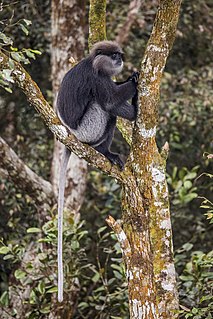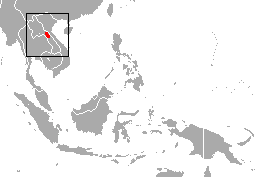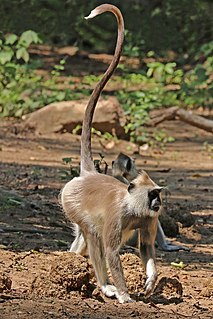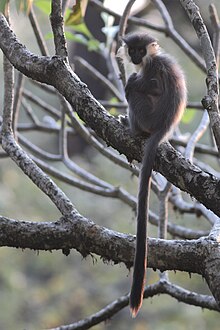
Gray langurs, also called Hanuman langurs and Hanuman monkeys, are Old World monkeys native to the Indian subcontinent constituting the genus Semnopithecus. Traditionally only one species Semnopithecus entellus was recognized, but since about 2001, additional species have been recognized. The taxonomy has been in flux, but currently eight species are recognized.

The purple-faced langur, also known as the purple-faced leaf monkey, is a species of Old World monkey that is endemic to Sri Lanka. The animal is a long-tailed arboreal species, identified by a mostly brown appearance, dark face and a very shy nature. The species was once highly prevalent, found in suburban Colombo and the "wet zone" villages, but rapid urbanization has led to a significant decrease in the population level of the monkeys. It had traditionally been classified within the lutung genus Trachypithecus but was moved to the genus Semnopithecus based on DNA evidence indicating that is it more closely related to the gray langurs.

The lutungs, langurs, or leaf monkeys are a group of Old World monkeys in the genus Trachypithecus. Their range is much of Southeast Asia.

The surilis are a group of Old World monkeys in the genus Presbytis. They live in the Thai-Malay Peninsula, on Sumatra, Borneo, Java and smaller nearby islands. Besides surili, the common names for the monkeys in the genus also sometimes use the terms "langur" or "leaf monkey."

Gee's golden langur, also known as simply the golden langur, is an Old World monkey found in a small region of Western Assam, India and in the neighboring foothills of the Black Mountains of Bhutan. Long considered sacred by many Himalayan people, the golden langur was first brought to the attention of the western world by the naturalist Edward Pritchard Gee in the 1950s. Adult males have a cream to golden coat with darker flanks while the females and juveniles are lighter. It has a black face and a long tail up to 50 cm (19.69 in) in length. It lives in high trees and has a herbivorous diet of ripe and unripe fruits, mature and young leaves, seeds, buds and flowers. The average group size is eight individuals, with a ratio of several females to each adult male. It is one of the most endangered primate species of India and Bhutan.

The Nilgiri langur is a langur. This primate has glossy black fur on its body and golden brown fur on its head. It is similar in size and long-tailed like the gray langurs. Females have a white patch of fur on the inner thigh. It typically lives in troops of nine to ten monkeys. Its diet consists of fruits, shoots and leaves. The species is classified as vulnerable due to habitat destruction and poaching for its fur and flesh, the latter believed to have aphrodisiac properties.

The silvery lutung, also known as the silvered leaf monkey or the silvery langur, is an Old World monkey. It is arboreal, living in coastal, mangrove, and riverine forests in Peninsular Malaysia, Sumatra, and Borneo.

Delacour's langur or Delacour's lutung is a critically endangered species of lutung endemic to northern Vietnam. It is named for French-American ornithologist Jean Théodore Delacour.

François' langur, also known as Francois' leaf monkey, the Tonkin leaf monkey, or the white side-burned black langur is a species of lutung and the type species of its species group. It is one of the least studied of the species belonging to the Colobinae subfamily.

The Cat Ba langur, also known as the golden-headed langur, is a critically endangered species of langur endemic to Cát Bà Island, Vietnam. It is among the rarest primates in the world, and possibly the rarest primate in Asia, with population size estimated at less than 70 individuals.

Phayre's leaf monkey, also known as Phayre's langur, is a species of lutung native to South and Southeast Asia, namely India, Bangladesh and Myanmar. Populations from further east are now thought to belong to other species. It is listed as Endangered on the IUCN Red List and is threatened by hunting and loss of habitat. The species epithet commemorates Arthur Purves Phayre.

The northern plains gray langur, also known as the sacred langur, Bengal sacred langur and Hanuman langur, is a species of primate in the family Cercopithecidae.

The Laotian langur or white-browed black langur is a species of primate in the family Cercopithecidae. It is endemic to Laos. Its natural habitat is subtropical or tropical dry forests. Genetically the Indochinese black and Hatinh langurs are very close to the Laotian langur, and consequently it has been suggested they should be considered subspecies of it.

The dusky leaf monkey, also known as the spectacled langur, or the spectacled leaf monkey is a species of primate in the family Cercopithecidae. It is found in Peninsular Malaysia, Myanmar and Thailand, and can occasionally be found in Singapore. During the day, these small, folivorous primates divide in sub-groups and forage for vegetation and fruit throughout the tropical forests. According to the IUCN, the dusky leaf monkey's population is declining due to habitat loss, poaching, and anthropogenic land use, which prompted the IUCN to classify the species as endangered in 2015.

Germain's langur is a lutung native to Thailand, Burma, Cambodia, Laos and Vietnam. The Old World monkey was previously included in Trachypithecus cristatus and Trachypithecus villosus.

The tufted gray langur, also known as Madras gray langur, and Coromandel sacred langur, is an Old World monkey, one of the species of langurs. This, like other gray langurs, is mainly a leaf-eating monkey. It is found in southeast India and Sri Lanka. It is one of three Semnopithecus species named after characters from The Iliad, S. hector and S. ajax being the others. In Sinhala it is known as හැලි වදුරා.
Pakke Tiger Reserve, also known as Pakhui Tiger Reserve, is a Project Tiger reserve in the Pakke Kessang district of Arunachal Pradesh in northeastern India. The 862 km2 (333 sq mi) reserve is protected by the Department of Environment and Forest of Arunachal Pradesh. In a notification (CWL/D/26/94/1393-1492) dated Itanagar 19 April 2001, issued by the Principal Secretary, the Governor of Arunachal Pradesh renamed Pakhui Wildlife Sanctuary as Pakke Wildlife Sanctuary Division.

Horsfieldia kingii is a dioecious tree of the family Myristicaceae. It grows up to 20 m tall and has large seeds that are dispersed by frugivores such as hornbills and imperial pigeons. The fruiting period is from February to May. The fruit is an arillate capsule and is bi-coloured.

The western purple-faced langur, also known as the north lowland wetzone purple-faced langur, is a subspecies of purple-faced langur endemic to Sri Lanka. It lives in the wet zone in western Sri Lanka around the former capital city of Colombo. This subspecies are known to live in tropical rainforest, specifically in an area of Sri Lanka, where it is noted to rain two times more compared to the neighboring region. The subspecies is generally gray-brown with lighter whiskers, a gray rump patch, and dark forearms and legs. These monkeys also have dark brown or black, hairless faces. Their hands and feet are also hairless. When infants, their fur is medium brown to light gray, however it changes to their darker adult colors at between 12 and 16 weeks old. Typical length is between 48 and 67 centimetres excluding tail, with a 59 to 85 centimetres tail. On average, males weigh 8.5 kilograms (19 lb) and females weigh 7.8 kilograms (17 lb). Their average life span is about 26 years if the monkey was held in captivity. Due to their leafy diet, the western purple-faced langur back teeth, include high crowns and pointed cusps to make eating through greenery simpler. They also developed a digestive system that would allow them to break down cellulose in the leaves they eat. Although, leaves are their primary source of food, they also eat fruits and flowers. Female langurs hold a pregnancy for 195-210 days, and after the birth the offsprings are taken closely cared for by the mother until they are about 12-20 weeks old.

The West Javan langur is an Old World monkey from the Colobinae subfamily. It was formerly considered a subspecies of Trachypithecus auratus until it was elevated to a separate species by Roos and Groves. It is listed as vulnerable by the IUCN. Its range is restricted to the island of Java west of Jakarta. Its range is currently restricted to Ujung Kulon National Park, Muara Angke Wildlife Reserve and Muara Gembong due to industrial development, habitat fragmentation and the disconnection of protected areas. They are known to eat the leaves and fruits of Sonneratia in mangroves.





















